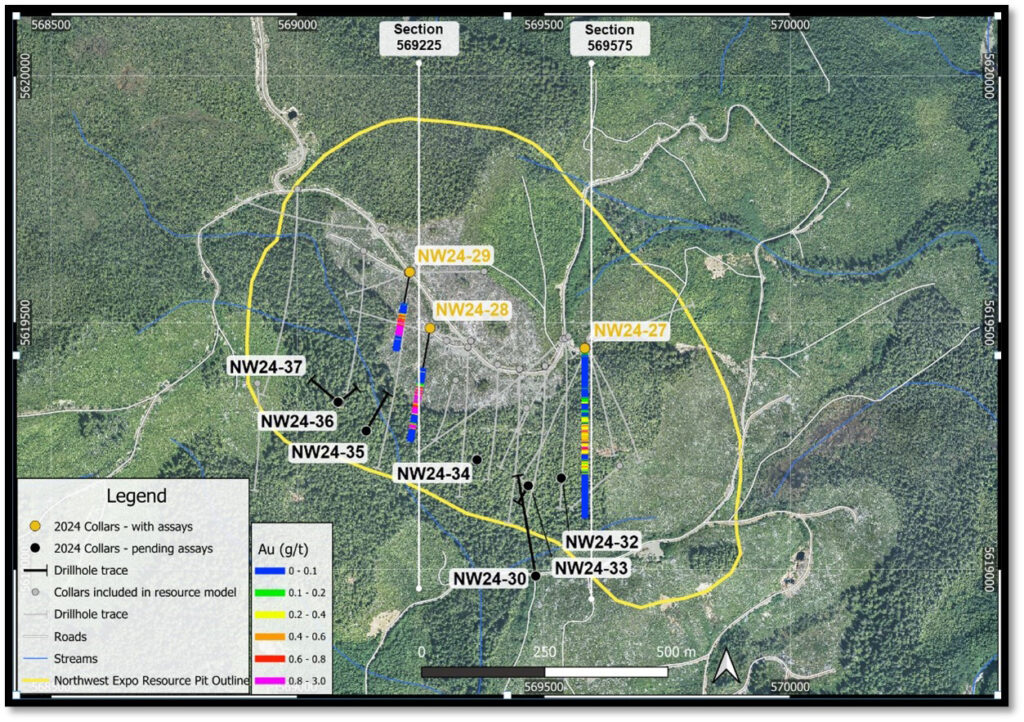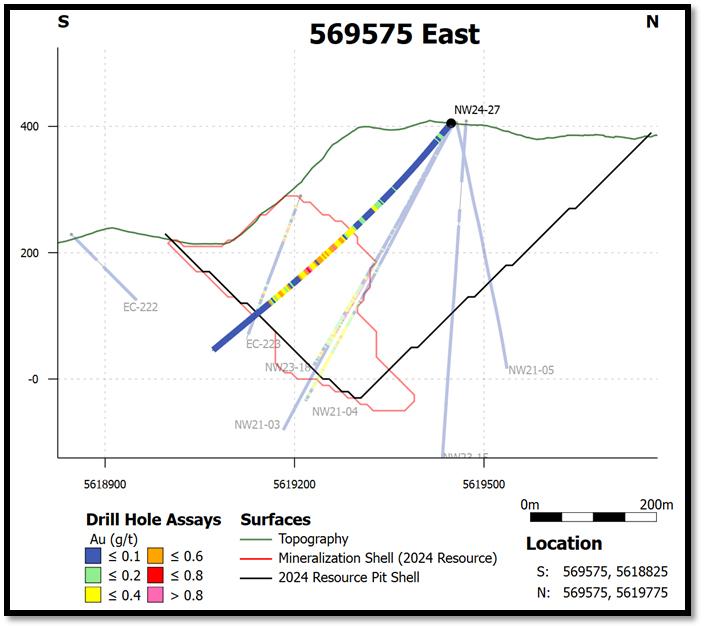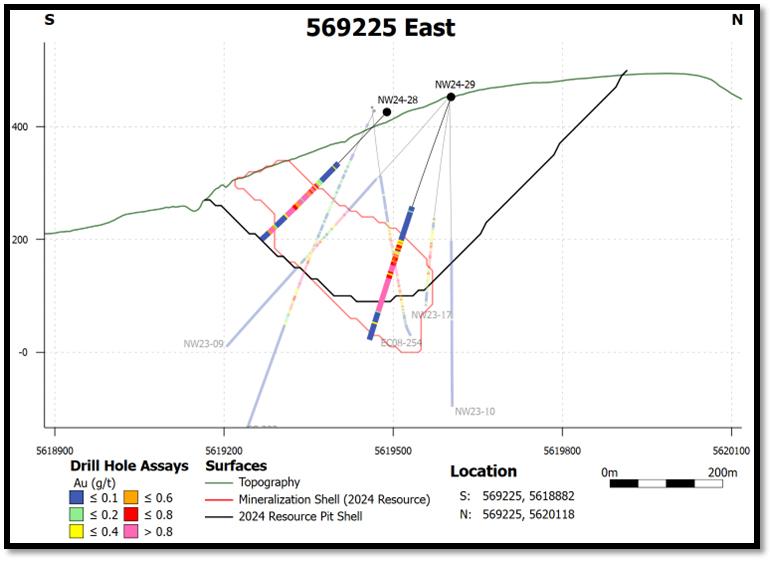
Northisle Announces Drill Results at Northwest Expo Including 132.8m Grading 1.49g/t Au Eq.

Highlights:
- NW24-27 included a 120m interval grading 0.57g/t Au Eq. and an additional 48m grading 0.35g/t Au Eq., and was successful in testing the eastern extent and potential feeder zone of the Northwest Expo deposit
- NW24-28 included 81m grading 1.26g/t Au Eq. and is above the resource block grade from the recent 2024 resource estimate in this up-dip, near-surface portion of the model
- NW24-29 intercepted 132.8m grading 1.49g/t Au Eq., including 33m grading 2.66g/t Au Eq., and similarly is above the resource block grade in this portion of the resource estimate
- Many of the assays contained elevated molybdenum and rhenium values which suggest that recovery of these metals should be investigated in future studies
- All holes drilled contributed meaningful structural knowledge and have provided further support for potential primary hypogene porphyry mineralization at depth
Northisle Copper and Gold Inc. (TSX-V: NCX) is pleased to announce that assays from the first five drill holes of the Company’s 2024 drill program at Northwest Expo have now been released.
NW24-27, NW24-28 and NW24-29 all included lengthy intercepts of mineralization, and demonstrated the potential for future improvements to the resource estimate of this deposit with grades reporting above the block grades in the recently issued resource estimate for the North Island Project. In addition, 2024 drilling at Northwest Expo has successfully achieved the Company’s secondary objectives of providing additional vectoring information, with several holes indicating increasing vein density at depth as a possible vector to a potential source porphyry intrusion. NW24-30 and NW24-31 stepped out from known mineralization and provided important structural understanding which is described further below but did not intercept economically significant mineralization.
Significant grade intervals from 2024 drilling at Northwest Expo are shown in Table 1.
Table 1: Northwest Expo Significant Intercepts
| Hole ID | From (m) | To (m) | Interval (m) | Au Grade (g/t) | Cu Grade (%) | Mo Grade (ppm) | Re Grade (g/t) | Au Eq.
Grade (g/t) |
Cu Eq. Grade (%) |
| NW24-27 | 225 | 345 | 120 | 0.43 | 0.10 | 166 | 0.51 | 0.57 | 0.42 |
| including | 285 | 345 | 60 | 0.50 | 0.18 | 121 | 0.46 | 0.74 | 0.55 |
| and | 360 | 408 | 48 | 0.28 | 0.05 | 42 | 0.01 | 0.35 | 0.26 |
| NW24-28 | 180 | 261 | 81 | 0.99 | 0.22 | – | – | 1.26 | 1.05 |
| NW24-29 | 270 | 402.8 | 132.8 | 1.19 | 0.27 | 50 | 0.60 | 1.49 | 1.31 |
| including | 290 | 402.8 | 112.8 | 1.30 | 0.30 | 50 | 0.47 | 1.65 | 1.45 |
| & includes | 356 | 389 | 33 | 2.10 | 0.50 | 46 | 1.01 | 2.66 | 2.36 |
Note: In table “-“ indicates background level assays. Intervals are approximately true widths as the drill holes were targeted perpendicular to the ore body as shown in Figures 2 and 3. Intervals were selected based on continuous intercepts with a copper grade above 0.1% Cu or a gold grade above 0.1g/t Au combined with geological interpretation. Totals may not add due to rounding. NW24-30 and NW24-31 did not intercept economically significant mineralization.
Note on equivalent calculation:
Equivalent grades are calculated as follows, which reflect the differences in recoveries, payables and metal prices between the deposits, as further detailed in the Company’s recent resource estimate for the North Island Project as disclosed on October 10, 2024.
- Metal prices of Cu = US$4.00/lb, Au = US$1,910/oz, as well as Mo = US$21/lb and Re = US$1,777/kg
- Cu Eq.: Chlorite-magnetite (CMG) alteration: Cu Eq. = Cu + Au*0.888; Non-CMG: Cu Eq. = Cu + Au*0.737
- Au Eq.: CMG: Au Eq. = Au + 1.126*Cu%; Non-CMG: Au Eq. = Au + 1.358*Cu%
Robin Tolbert, Vice President Exploration stated, “We are encouraged by the initial 2024 results from Northwest Expo, which have improved on the block model grade in this area of the resource estimate and have provided additional vectoring information towards a potential porphyry source.” Assays from the remainder of the 2024 Northwest Expo drill program are anticipated by the end of 2024.
Northwest Expo Drill Result Details
Assay results have now been received for five of the eleven drill holes completed during 2024 on the Northwest Expo deposit and surrounding area. Results presented today include holes NW24-27 through NW27-31. NW24-27 to NW24-30 were drilled with dual objectives in mind: upgrading the inferred resource and exploring for potential vectors at depth to aid near field targeting for hypogene porphyry mineralization in 2025. All holes reported were oriented, and NW24-27 to NW24-30 were drilled from existing or reactivated forest service roads and drill pads from 2023. NW24-31 was drilled from a helicopter pad approximately 2km southeast of the resource footprint.
Assay results from NW24-27 confirm the eastern extents of the resource at Northwest Expo. Grades pinch out to the southeast, in support of recent surface structural interpretation. Late structural off-set appears to have dislocated the mineralized body at Northwest Expo, creating the potential to identify fault-offset mineralization in multiple directions.
Both NW24-28 and NW24-29 were successful in intersecting encouraging vein texture and alteration suggesting the potential for underlying classic porphyry-style mineralization. Increased proportions of porphyry-related veins in the breccia which hosts the highest grades in Northwest Expo, as well as encouraging high temperature clay alteration below the mineralized breccia help place the Northwest Expo deposit in the upper levels of a potentially telescoped porphyry-lithocap system.
NW24-30 was drilled to test for a potential fault offset to the south of known mineralization at Northwest Expo. The hole did not intercept economically significant mineralization but confirmed the presence and informed the dip direction of the fault zone which has contributed to an improved understanding of the structure of this area and will aid in future vectoring to the potential location of the hypothesized causative intrusion in this area.
NW24-31 was drilled to test a magnetic anomaly approximately 2km to the southeast of known mineralization at Northwest Expo and intersected intense quartz-sericite-pyrite (“QSP”) alteration which is interpreted to indicate proximity to another porphyry source in this area, but did not intercept economically significant mineralization. The drill pad for this hole has been left in place to support future drilling in this area.
Assays from the remainder of the Northwest Expo drill program are anticipated by the end of 2024. Additional details from the reported drill holes can be found below.
Table 2 shows the collar data for the holes drilled and reported from Northwest Expo in 2024.
Table 2: Northwest Expo 2024 Drill Hole Collar Locations for Released Holes
| Hole ID | Length (m) | UTM East | UTM North | UTM Elevation | Azimuth | Dip |
| NW24-27 | 528 | 569580 | 5619448 | 405 | 180 | -50 |
| NW24-28 | 321 | 569267 | 5619491 | 425 | 190 | -45 |
| NW24-29 | 456 | 569229 | 5619599 | 453 | 190 | -70 |
| NW24-30 | 360 | 569484 | 5618987 | 211 | 350 | -55 |
| NW24-31 | 489 | 570991 | 5618197 | 181 | 50 | -60 |
Relogging of core, localized surface mapping, and a recent high definition heliborne magnetic gradient survey resulted in positive refinement of the exploration model at Northwest Expo. In late 2023 and early 2024 Northisle geologists observed several generations of porphyry related quartz vein arrays and weak quartz stockworks in the deepest portions of the Northwest Expo system which supplied vectors towards mineralization at depth. The first four holes at Northwest Expo in 2024 sought to follow up on these vectors and potentially upgrade the inferred resource. NW24-27, NW24-28 and NW24-29 were successful in intersecting increased porphyry related veining related to high grade samples associated with encouraging QSP alteration. Interpretation of the 2024 gradient magnetic survey suggests the potential for several late off-setting faults which has contributed to improved structural understanding in this area. The late off-setting faults suggest the western and eastern extents of the deposit remain open to the southwest and northeast, respectively, dependent on further interpretation of the throw of said fault. Mapping and core analysis focusing on structure is currently in the planning stages and is anticipated to be executed before drilling in 2025.
Figure 1 shows the Northwest Expo deposit in plan view, with sections and current results highlighted. Figures 2 and 3 show cross-sectional views of NW24-27 through NW24-29 with the 2024 resource estimate pit shell and mineralized shell included. Systematic variation in texture from NW24-28 to NW24-29 on the same section supports the theory that mineralization within the current Northwest Expo resource is related to a potentially fertile porphyry system at depth. Discontinuous mineralization in NW24-27 supports the potential for late brittle-ductile offset which leaves the system open in both east and west directions, while maintaining prospectivity at depth.
NW24-28 and NW24-29 were drilled in the west-central portions of the resource. NW24-28 and NW24-29 intersected significant grades, with NW24-29 being higher grade than anticipated, within significant lengths of magmatic hydrothermal breccia with intense CMG alteration. The upper levels of this breccia hosted xenoliths of chalcopyrite-magnetite stockwork veined feldspar porphyry. Grades increase up-dip towards surface, as confirmed in NW24-28.
NW24-27 intersected mineralization and alteration consistent with interpretation that the eastern margin of the deposit is off-set by late faulting. The hole was extended to 528m after intersecting a low-grade mineralized intrusive with porphyry related banded parallel vein sets and multiple orientations of D-vein arrays, bolstering the Northwest Expo exploration model and vectoring efforts. The low copper grades in the lower intercept in this hole are interpreted as late acid overprint remobilizing Cu to the overlying magmatic-hydrothermal breccia, while the gold remains in the early quartz-magnetite veins.
Upcoming Catalysts
In 2024, the Company will continue advancing the North Island Project, with development and exploration catalysts throughout the year leading to measurable impacts for shareholders, including the following:
- COMPLETED – Geophysics results from Northwest Expo and West Goodspeed
- COMPLETED – Northwest Expo metallurgical testing and initial resource estimate
- COMPLETED – Final 2023 Pemberton Hills Drill Results
- COMPLETED – Commencement of 2024 drilling program
- COMPLETED – Preliminary Project Trade-offs
- COMPLETED – Commencement of advanced economic and technical studies
- COMPLETED – Drill results from West Goodspeed
- COMPLETED – Integrated North Island Project Mineral Resource Estimate
- Q4 2024 – Additional Exploration Results from Northwest Expo
- Q4 2024 – Additional Exploration Results from West Goodspeed
- Q4 2024 – North Island Project Resource Estimate Technical Report
- Q4 2024 / Q1 2025 – North Island Project Updated PEA
- Ongoing – Continued respectful engagement with indigenous rightsholders and local stakeholders
Additional Technical Details
Logging, Sampling and Assaying Procedures and QA/QC
The diamond drill core logging and sampling program was carried out under a rigorous quality assurance / quality control program. Drill intersections in this release are typically HQ to 100 m and NQ thereafter to the end of holes. After drilling, core was logged for geology, structure, and geotechnical characteristics utilizing Geospark© core logging software, then marked for sampling and photographed on site. The cores for analyses were marked for sampling based on geological intervals with individual samples 3 m or less in length. Drill core was cut lengthwise in half with a core saw. Half-core was sent for assays reported in this news release. Prior to cutting core for assay bulk density was also determined on site by taking 15 to 20 centimetres (cm) lengths of whole core of each lithology at 10 m intervals. The ends of these were then cut at right angle to the core axis, retaining all pieces to be returned to the core box for later sample cutting and analysis. The diameter of each core sampled for bulk density was measured at each end with digital calipers to 3 decimal places and recorded. The length of the core was measured on four sides at 90 degrees to each other, to 2 decimal places and recorded. The software averaged the lengths and diameters. The mass of the dry core was measured twice on an Ohaus© balance to 2 decimal places. If no discrepancy occurred the measurement was recorded. If there was a discrepancy the measuring was repeated until no discrepancy between 2 measurements occurred. The density was calculated using the formula Bulk Density = π times r² times h (where r is radius of core and h is length of core). Certified standard masses are used to calibrate the scale balance used for bulk density determinations. The balance in the core logging area was levelled on a large concrete block to avoid vibration, was leveled, and surrounded by a wooden partition to avoid wind affecting the balance. The measurements were recorded in Geospark© logging software and Bulk Density calculated to 2 decimal places.
A total of 5% assay standards or blanks and 5% core duplicates are included in the sample stream as a quality control measure and are reviewed after analyses are received. Standards were obtained from WCM Minerals, Vancouver, CDN Minerals, Langley and OREAS, Canada. Blanks were obtained from unmineralized course bagged limestone landscaping rock. Standards and blanks in 2024 drill results to date have been approved as acceptable. Duplicate data add to the long-term estimates of precision for assay data on the project and precision for drill results reported is deemed to be within acceptable levels. Samples were sent to the MSALABS in Langley, BC where the samples were dried, then crushed, split and a 250 gram (g) split was pulverized to 85% passing -200 mesh (-75 micrometres (µm)) size pulps. Clean crush material was passed through the crusher and clean silica was pulverized between each sample. The pulps were analyzed for gold by fire assay fusion of 50 g of the 250 g split. Total gold content was determined by digesting the silver doré bead from the fusion and then analysing by AA (MSA Code FAS-121). All samples were also analyzed for multiple elements by taking a 0.25 g of the 250g split which was heated in HNO3, HClO4 and HF to fuming and taken to dryness. The residue was dissolved in HCl and then analyzed utilizing ICP-MS (MSA Code IMS-230). Any sulphur analysis from this latter analysis with a value greater than 10% was reanalyzed utilizing a Leco sulfur analyzer. Iron and Tungsten accelerators are added to the sample and a stream of oxygen is passed over the sample in the induction furnace. As the sample is heated, sulfur dioxide released from the sample is measured by an IR detection system and the Total Sulphur content is determined. (MSA Code SPM-210). MSALABS (Langley) is an independent, international ISO/IEC 17025:2005 accredited laboratory.
Pulps and rejects of holes with significant assay intervals are stored at Western Mineral Storage. The remaining split core is indexed and stored at Northisle logging and office facility in Port Hardy, BC.
Drill Results in this news release are length weighted averages.
Qualified Persons and Data Verification
Robin Tolbert, P.Geo., Vice President Exploration of Northisle, and a Qualified Person as defined by National Instrument 43-101 Standards of Disclosure for Mineral Projects, has reviewed and approved the scientific and technical disclosure contained in this news release and has verified the data disclosed, including the sampling, analytical and test data underlying the disclosure.
About Northisle
Northisle Copper and Gold Inc. is a Vancouver-based company whose mission is to become Canada’s leading sustainable mineral resource company for the future. Northisle, through its 100% owned subsidiary North Island Mining Corp., owns the North Island Project, which is one of the most promising copper and gold porphyry projects in Canada. The North Island Project is located near Port Hardy, British Columbia on a more than 34,000-hectare block of mineral titles 100% owned by Northisle stretching 50 kilometres northwest from the now closed Island Copper Mine operated by BHP Billiton. Northisle completed an updated preliminary economic assessment for the North Island Project in 2021 and is now focused on continued advancement of the project while exploring within this highly prospective land package.

Figure 1: Plan View of Northwest Expo with Reported Holes Highlighted (Graphic: Business Wire)

Figure 2: Cross-section 569575 East with NW24-27 Highlighted (Graphic: Business Wire)

Figure 3: Cross-section 569225 East Showing NW24-28 and NW24-29 (Graphic: Business Wire)
MORE or "UNCATEGORIZED"
CRML Announces Another Set of Outstanding Rare Earth Elements Results From Its 2024 Drilling Program at Tanbreez. These Elements & Results Include: Niobium Pentoxide of Up to 1,746 ppm, Cerium Dioxide 1711 ppm, Gallium 103 ppm & Hafnium 484 ppm- Mineralisation Has Been Confirmed to Occur Consistently Across All Drilling Locations and at Surface
GREENLAND, TANBREEZ ASSET DRILLING REE HIGHLIGHTS: Consistent R... READ MORE
Rio2 Announces Closing of Upsized Bought Deal for Gross Proceeds of C$191 Million
Rio2 Limited (TSX: RIO) (OTCQX: RIOFF) (BVL: RIO) is pleased to a... READ MORE
Cerro de Pasco Resources Strengthens Social License with the Community of Quiulacocha
Cerro de Pasco Resources Inc. (TSX-V: CDPR) (OTCQB: GPPRF) (FRA: ... READ MORE
Osisko Development Provides Infill Drilling Update on Its 13,000-m Program at Cariboo Gold Project; Intercepts Include 8.56 g/t Au Over 8.5m from 60.5m Depth, and 130.32 g/t Au Over 0.5m from 83.5m Depth
HIGHLIGHTS 5,983 m of infill drilling completed (3,704 m of new r... READ MORE
Yorbeau Closes Non-Brokered Private Placement
Yorbeau Resources Inc. (TSX: YRB) is pleased to announce that it ... READ MORE












